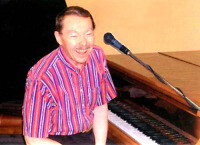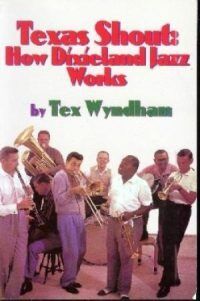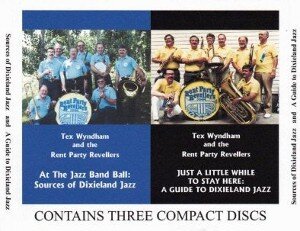The following introduction ran in our predecessor paper, The American Rag, before the Texas Shout columns were reprinted in the paper beginning in 1998
Introduction to The American Rag Texas Shout Reprints By Tex Wyndham
Shortly after my “Texas Shout” column began appearing in these pages, the editor told me that it was the paper’s most popular feature. During its nearly seven-year lifetime, it dealt primarily with the characteristics of Dixieland jazz and, to a lesser extent, ragtime; the environment in which those musics were then most commonly found; and how the music interrelated with the scene.
The full run of “Texas Shout” has been collected into a lavishly illustrated trade paperback entitled Texas Shout: How Dixieland Jazz Works. In connection with the volume’s publication, The American Rag is inaugurating a series of reprints of selected material from the columns. The first is scheduled to appear in the next issue. To orient new readers, and for the benefit of any “Texas Shout” completists in the crowd, set forth below is the book’s introduction, basically the only textual material therein that did not previously appear in The West Coast Rag or American Rag.
Introduction to Texas Shout: How Dixieland Jazz Works by Tex Wyndham
The text of this volume speaks for itself. However, to orient you properly, I should tell you a little about the source of that text.
This book presents, in the order of their publication, all of the “Texas Shout” columns I wrote for West Coast Rag/The American Rag from the column’s inception in the November/December 1989 issue through the August 1996 column that marked its conclusion as a newly written every-issue feature. (To be precise, one column was not newly written. January 1990 was reprinted from the August 1989 Jersey Jazz.)
No attempt has been made to update these columns to the present. First, doing so would involve too much rewriting. Second, if we did try, something would go out of date before the final printing anyway. Thus, you will see references to recordings and other products that may no longer be on the market; prices, addresses and phone numbers that may not be current; musicians who are no longer among the living; bands that have disbanded; etc.
The columns were meant to be self-contained and to be digested, not in one gulp as you are about to devour them, but over a period of nearly seven years. Thus, you will find points repeated in summary form that were made in earlier columns but resurrected to support the argument of a later one. Again, an attempt to minimize such repetition would have essentially involved starting from scratch to reorganize and rewrite the entire text.
West Coast Rag began as an eleven-times-a-year tabloid published by Woody and Pat Laughnan. It acted as a social calendar for the Dixieland and ragtime festival scene on the West Coast.
While retaining its basic focus on festivals, it quickly became national in scope and increased its circulation until it was one of the country’s two leading independent periodicals focusing on Dixieland and ragtime. In mid-1995, Don Jones took it over from the Laughnans, renaming it The American Rag.
“Texas Shout” is based on two of my most deeply held beliefs:(1) The more you know about something, the more likely you are to enjoy it and stick with it. (2) Dixieland jazz and ragtime, like all other valid art forms, are not in any way dated.
Specifically, Dixieland and ragtime are worth pursuing for their own sakes and have much to say to a contemporary listener who understands them. If artists from the turn of the century could use the conventions of these two musics to create something timeless in its appeal, then today’s artists can do the same thing provided they approach the task with searching creative spirits.
“Texas Shout” drew on my experiences over the decades as a writer, bandleader and performer of Dixieland and ragtime. This background was utilized to organize and discuss these musics along the above lines.
In doing so, I reached certain conclusions that are at odds with the conventional wisdom in the field. Therefore, I suspect that a number of readers will disagree with some or all of what I have to say.
Whether you agree or not, I’ll have accomplished my purpose if this volume causes you to think through your position in a new way. I hope that the exercise will broaden your ability to appreciate music that has brought me, and many others, a great deal of pleasure.
This book would not exist without Dan and Sis Polin, of Dan Jazz Enterprises, my friends and producers. Dan, who believes that there are enough of you who care what I have to say about Dixieland and ragtime (music that has all but disappeared from the general musical marketplace) to justify this tome, has acted as jack-of-all-trades in the production, illustration, layout and other hard work involved in preparing a book for publication. Sis has done the painstaking data input and other detailed labor required to get the text onto computer discs in a format for reproduction in a published form.
Nor would this book have come to pass without three people whose unquestioning support of my interests in obscure old music, movies and fiction enabled me to get deeply enough involved in them to form opinions about them: My parents, Charles (deceased) and Louise Wyndham, and my wife Nancy. Mom and Dad, bless their hearts, never really understood much about jazz. However, if I wanted to play it, that was fine with them. They were proud of whatever I did, no matter how arcane.
Nancy is perceptive and knowledgeable about Dixieland and ragtime. In addition to her dedicated toil as my wardrobe mistress, sales manager, etc., she has been a very valuable sounding board as well as de facto editor for my writings.
In the 1960s, except for an occasional local gig, my musical activity consisted of amusing myself in the music room and basement of my Wilmington, Delaware home. I would still be in that position except for many generous people, some of whom have since departed this world, who opened their homes, sheet music collections, etc., to me, and who undertook to get me out into the larger musical community.
Space prohibits naming all of them, so the following short list will have to act as a surrogate for the complete registry: Fred and Anna Wahler, Johnson and Liz McRee, Shannon Clark, Keith Miller, Jack and Jean Cuff, Roger Hankins, Mike Montgomery, Charlie Rasch, John Arpin, Bill and Mary Cay Donahoe, Bill and Mimi Barnes, Alan Granruth.
On the technical side, typographical and proofreading errors appearing in the original published columns have been tacitly corrected. We hope no new ones have been introduced, though our four-person proofreading team is inevitably not as eagle-eyed as that of, say, a major publishing house.
Quite a few columns ran over more than one issue of West Coast Rag/The American Rag. In those cases, we have indicated where the original breaks occurred by a line of diamond symbols.
I did not title the original columns. However, so that I could find relevant columns easily for reference purposes, I kept offhandedly fashioned working titles on a sheet of paper. These titles have been included here for whatever use they may be to you.
We have not indexed this book for two reasons. First and foremost, I don’t consider it to be the type of reference book for which an index is necessary; the chapter titles should get you where you want to go. Second, none of us is willing to do the work required to compile an index.
In closing, as this is probably the only time when I’m going to have a chance to mention special people in a book of mine, I would like to say that my two children, Buck and Susan, have been steady sources of pride and joy in these quarters. I won’t keep you from the rest of this volume any longer. Keep swinging
Tex Wyndham
September 1996
From roughly 1970-2010, Tex Wyndham was: (1) one of the best-known revivalist Dixieland jazz musicians in the US, as cornetist, pianist and bandleader, (2) one of the best-known ragtime pianists in the US, and (3) one of the most respected critics in the US of Dixieland jazz, ragtime, and related music. He is the only person about whom all three of those statements can be made.




 The full run of “Texas Shout” has been collected into a lavishly illustrated trade paperback entitled Texas Shout: How Dixieland Jazz Works. This book is available @ $20.00 plus $2.95 shipping from Tex Wyndham. On request, Tex will autograph the book and add a personalized note (be sure to tell him to whom the note should be addressed).
The full run of “Texas Shout” has been collected into a lavishly illustrated trade paperback entitled Texas Shout: How Dixieland Jazz Works. This book is available @ $20.00 plus $2.95 shipping from Tex Wyndham. On request, Tex will autograph the book and add a personalized note (be sure to tell him to whom the note should be addressed).